Lightning
On 20160129 (29th Jan) Sydney had a very violent thunder and lightning storm in the mid afternoon. It was kind of weird; originally a fine day, it clouded over fast together with a lot of lightning. There was not much rain, and no wind at all in my area. It came on so fast that I hadn't decided to shut down and disconnect all the electronics, when suddenly around 4pm there were several very close-by strikes. A couple made the power drop out for fractions of a second but the PC didn't crash. I was just getting up to start pulling plugs out in the LAN closet, when WHAM. A very close strike. The mains power failed at the instant of the strike. It stayed out till 9pm. Discussion here.An hour later the sky was clear blue again. Then around 10pm another similar storm, that also developed very quickly. With that one I'd phone-ordered a pick-up pizza while there was no storm, then 15 minutes later I went to pick it up in an extreme downpour, that I could barely see to drive through. Not so much lightning that time, and the power stayed on. Incidentally in Sydney mid-summer it never really gets cold, storm or not, so sitting eating pizza with squelching wet shoes is better than changing to dry shoes, by which time the pizza wouldn't be so hot.
The 4pm power loss meant no more activity in my workshop that day, since it doesn't have enough natural lighting. After setting up my little car-camping battery light (but of course still no PC, net or power tools), I decided to go for a walk. See if I could locate where the problem was, and phone it in, if they didn't seem to know already.
Unlike a couple of prior recent storms that had high wind gusts and lots of tree-fall damage to power lines, this day there was no wind damage at all. Not even extra leaves and twigs on the ground. It really had been completely calm. My hunt for the cause of the power outage developed into a bit of a saga of driving around mentally mapping the HV power distribution lines, and where they drop down to transformers supplying the street level 3-phase 240V lines. (Different system than in the USA.)
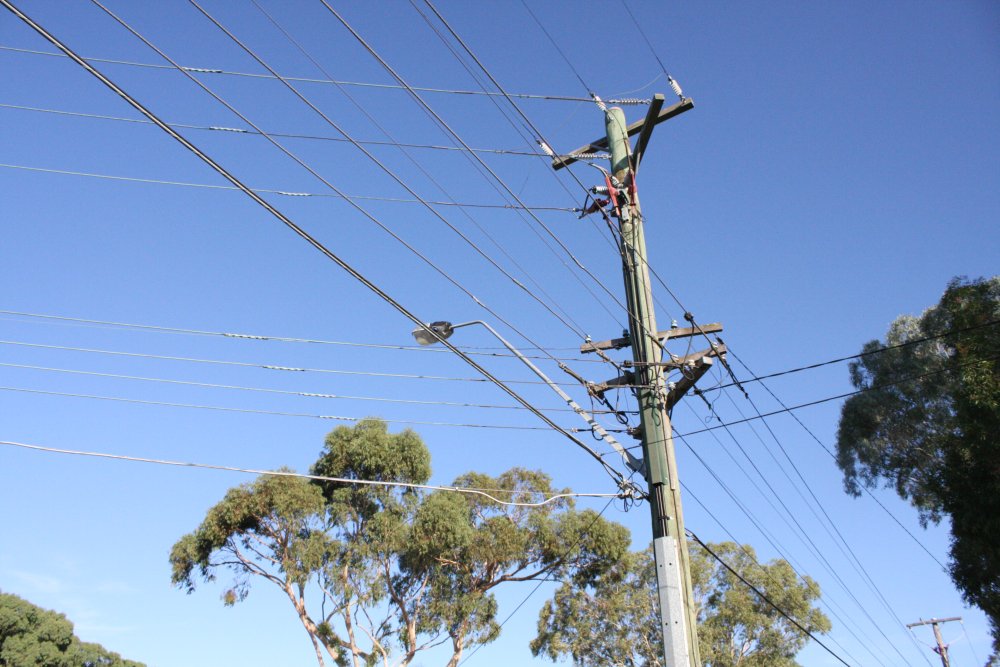
This photo was taken at 6:20pm that day, about an hour and a half after the storm. Yes, the sky was that clear. Also those power lines are dead at that time. The various lines are, starting from the top:
- Three phases of high voltage, 11,000V I think. Only three wires since there is no Neutral line. This pole is at a V-junction; also there are cables running down the pole to go underground to a nearby step-down transformer. One set of the overhead wires are heavy cable, this will be the supplying line. The other set is light cable, this will be a minor branch extension (and in fact it's the branch that supplies my home's area.)
The distant pole at lower right also has three 11,000V lines terminating in down-pole cables to the same transformer. Note that the cables running down the poles and then underground have a HV core, insulation, a grounded sheath of steel wires, then more insulation. They are effectively coaxial cables, also armored. The result is that you can't use an electrostatic field detector like a Fluke Volt-Alert to check if the cable is live, since with the grounded shield there is no external electric field. Doesn't matter, just walk to the nearby transformer and see if it's humming.
- Three quite thin wires on one cross bar. These will be 240V three phase, supplying street lighting along this power line run.
- The 415V three phase and neutral local supply. (240V phase to neutral.) These wires are relatively thick due to the higher current requirement. The neutral wire is grounded at both the main transformers, and customer boards.
- Finally at the lowest level, is the cable TV/Internet distribution system, an afterthought added to the poles not so long ago.
 Here's a typical street transformer, converting the high voltage three phase to the distribution 415V three phase supply. Other such transformers of smaller size are often mounted on the poles. For some reason I don't know, the street transformers always seem to be located some distance away from the pole(s) bringing down the HV supply and LV local outputs.
Here's a typical street transformer, converting the high voltage three phase to the distribution 415V three phase supply. Other such transformers of smaller size are often mounted on the poles. For some reason I don't know, the street transformers always seem to be located some distance away from the pole(s) bringing down the HV supply and LV local outputs.
It's easy to tell what is powered and what isn't - the transformers hum slightly when live. Put your ear against the transformer pole or street box transformer; it's as good as a power-on light.
Curiously there was zero visible storm damage (no trees or lines down, since there was no wind) and presumably the only damage being blown fuses or circuit breakers in street transformers. Meanwhile the electricity company phone operators kept insisting there was "massive widespread storm damage, service crews are working hard". But there being no sign of anyone doing anything over a wide area I'd driven around. Hmmm...
One of the two top-tier substations that carry all the power coming into Sydney is near my place, so I stopped by there. The sun had just set, so these are twilight photos. Incidentally, note the fairly recent walls around the transformers.
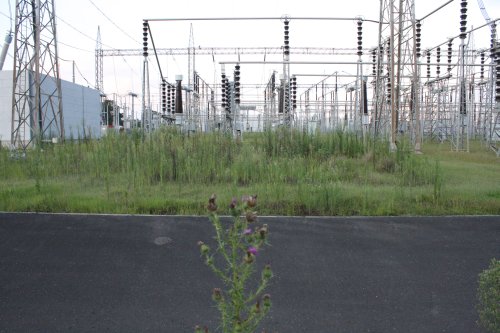 |
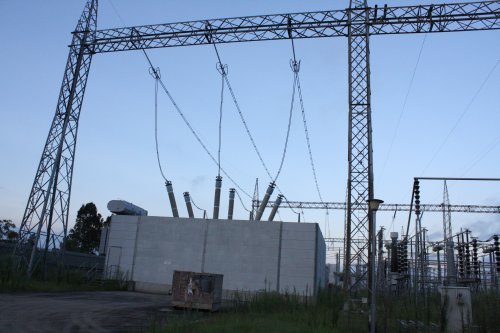 |
Used the gate intercom to speak with the ops room guys. They are 'Transgrid' - the company that handles long distance power distribution, like from the southern mountains hydro system, and northern coal-fired power stations. They knew nothing of any local problems in Sydney, since they don't have access to ops status from 'Ausgrid' - which handles electricity distribution in cities.
Shortly after dark (around 8pm) I'd spoken with a semi-trailer driver who delivered a huge diesel generator to a local supermarket. He said the storm had hit in Sydney's West around 2pm, and he'd been busy ever since delivering big generators all across Sydney. The electricity supply system used to be one State-run Authority, but then electricity supply was 'privatized', so now it's a mess of competing shell companies, all 'selling' through the one physical electricity grid that was originally taxpayer funded. Apparently these shell companies don't maintain much in the way of emergency repair crews, since according to the semi-driver, they weren't able to provide the big clients (with millions of dollars of stock in refrigeration) a sensible estimate of when power would be restored. Hence the panic renting of generators.
By that time I still hadn't seen even the faintest sign of any repair crews out searching for grid faults, or repairing them. Nor any actual visible damage. The power in my area came back on around 9pm, and I strongly suspect that's when someone finally got around to driving to whichever grid node or transformer had tripped circuit breakers, and turning them back on. Another example of Australian industry being hollowed out by corp-gov scammers, and not a good omen for the future. I doubt any of the ignorant fools pushing this kind of facade-economy have any idea the Sun is just starting to enter into another Maunder Minimum, with the global weather changes (dramatic cooling, not warming) and increased atmospheric electrical theatrics consequent to an attenuated Solar Wind, and the resulting increase in charged high energy cosmic rays penetrating the Heliosphere and reaching Earth's upper atmosphere.
So, I should expect an increasing frequency of such extended grid power failures. Inadequate repair infrastructure due to economic/political stupidity, and increasing violent thunderstorms not predicted by the current Global Warming faker ideology. All the more incentive to acquire myself an independent means of electricity supply, both for short and long term use.
While driving around that day, there were the usual piles of street-tossed junk here and there. In most Sydney suburbs, you ask the council for a 'pickup permission', put the stuff on the kerb and stick on it the notice they give you. Council trucks then pick it up sometime, usually several days later. Without the notice it's illegal dumping, with a big fine for those who are caught doing it.
 I'm a retired electronics engineer, and enjoy grabbing selected kinds of electronics junk from such piles, to disassemble for interest and some parts. I stopped at a few piles that afternoon and evening. At one, among the random junk there was a large cloth shopping bag full of DVDs.
I'm a retired electronics engineer, and enjoy grabbing selected kinds of electronics junk from such piles, to disassemble for interest and some parts. I stopped at a few piles that afternoon and evening. At one, among the random junk there was a large cloth shopping bag full of DVDs.
Normally such toss-outs would be crap, but I looked at the ones on top here and went 'oh cool!' They were all sci-fi. Good ones. It seemed to have been out for a few days, and well rained on. Partially under cover, and anyway dvds don't care. I grabbed that.
Also found a really nice armored leather motorcycle jacket. Damp, but I took it as well. I do a little urbex (urban exploring); a tough 'don't care about dirt and scrapes' jacket could be useful.
The jacket (once dry) turned out to fit me perfectly — which is quite a coincidence since I'm tall and long-armed. Also no visible wear at all.

The DVDs were cool. Easy to dry out the damp ones. Some were dry, due to the stack being partly under cover.
Of all the DVD packs, there was one unopened, in original shrinkwrap. An XBox Halo game. Which was one of the totally dry ones.
There were about 3 DVDs that were of no interest to me - a couple of rubbish movies, and that one (I don't have an XBox.)
Was going to bin them, then wondered if maybe someone would want the game. Didn't think there'd be much interest, especially
when seeing the huge number of similar items on ebay. It turned out there's a guy in the USA who's collecting hobby is 'unopened Xbox Halo packs', and he was pleased to get it for $5.
Of the several seemingly unlikely positive outcomes of that lightning strike, the DVDs were the first and that Halo was the second.
Other finds that day, were a 5-CD carosel CD player (relic of the days before solid state music players, and so an amusing museum piece), and an inverter-drive microwave oven. Another example inverter board for my collection. Also, there'd recently been a discussion on the eevblog electronics forum about whether microwave cooker magnetron cathodes were bare metal, or coated. Since I didn't need this old magnetron for anything I decided to cut it open and see for myself. Ideally ending up with a nice photograph of the intact cathode, to post.
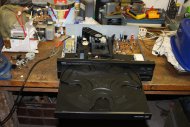 |
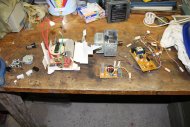 |
 |
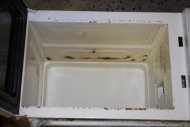 |
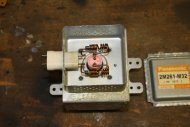 |
1: The carosel CD player. 2: The microwave oven guts. 3 & 4: Winner, most destroyed oven interior award. The case has actually rusted through in places. I wonder what that did to the external leakage field? 5: The cathode low-pass filter inductors. Interesting how they've staggered the coil spacing and ferrite, to give at least three different impedance zones, and presumably better broad-spectrum suppression.
 |
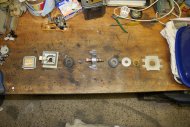 |
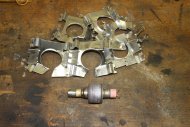 |
 |
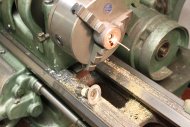 |
1 - 3: dismantling the magnetron assembly.
4: Starting out to cut the magnetron tube open neatly, in the lathe.
5: Antenna stub and end cap removed. The wire seen was crimped into the flattened end of the stub evacuation tube, which is then covered by the neat end cap. The wire carries the RF output, and the other end is attached to one of the internal resonant vanes, at a point chosen to give the desired RF parameters.
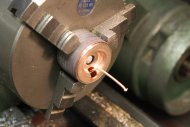 |
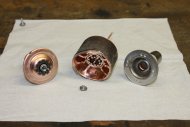 |
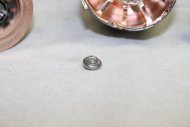 |
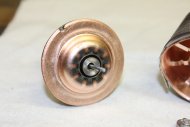 |
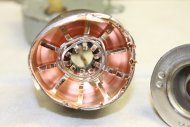 |
1: Closeup. The center silvery disk is the top of the cathode assembly. At this point I decided to cut through the face plate at the other end, ideally freeing the cathode assembly from the copper body with the vanes. Unfortunately I didn't think the machining process through at all. The cut started OK, but while nearing break-through there was one of those 'machinist accidents', where everything goes to hell extremely fast.
The problem here was that the cylindrical body of the magnetron is made of thin, soft copper. By itself it has little strength, and while it's clamped in the three jaws of the lathe chuck, what's keeping it in the shape of a cylinder is really the welded-on end caps.
As the end I was cutting into started to lose the support of the end cap, the body distorted under the pressure of the chuck jaws. The initial tiny distortion (outwards at some parts of the cylinder) shoved a suddenly deeper amount of copper against the cutting bit. Positive feedback - the more it distorted, the deeper the bit cut in, applying more distorting force.
The perception to the lathe operator (me) was everything fine one moment, then bang! All the pieces got ejected from the lathe at speed.
2, 3. The pieces I could find. The cathode filament spiral, being brittle tungsten, effectively vanished. (Fragments lost in the mess of swarf I hadn't cleaned up for a while, or just gone ping! across the room somewhere.) One small piece remains — the end cap and a couple of turns of the tungsten filament. Also the straight center rod survived, and it too appears to be tungsten. Anyway, objective achieved, there's no visible coating on the filament at all.
4. The base end cap. The gray pattern would be sputtered tungsten, masked by the ends of the resonant vanes in the body.
5. Mangled interior. All the vanes are identical stampings, only placed one way up or the other during assembly. The notches visible part way along every second one are only there for the one vane that has the output antenna wire brazed into that notch.
Ultra clean copper, before it oxidizes in air, is a very pretty colour.
Not so welcome Lightning effects
A little more than a week after that storm, on the 7th Feb, I was rearranging some equipment in the shelves over my desk. One problem with gear-stacks like this is what to do with all the power cords. They plug into extension boards since there are never enough wall outlets. But then if you want to unplug one instrument, since the cables are all shoved in a tangle down behind the gear, how to figure out which mains cord plug in an extension board is the one you want?This has always been a problem with equipment piles. All my life. A few times I'd tried putting tape labels on the cords, lettered with marker pen. But this becomes horrible eventually because the plasticisers in the PVC cord turn the tape adhesive into tacky gunk, and the tape becomes brittle and tears. Or just falls off due to the failed adhesive. So I don't do that any more.
It's so irritating, that this time I decided to apply a solution I'd thought of before but rejected as too far into obsessive-compulsive territory. Tag labels and string. Extreme measures, I know. And incidentally it was this 'had it with this sh*t' mood that led to the desk rack project a bit later.
 |
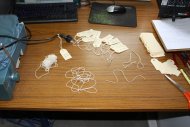 |
 |
1. What I'm talking about. That's 16+ mains cords just above and to the left of the bench.
2. Yeah, I actually bought the tags. String I had. Cotton, because it's more flexible, holds a knot, and lasts longer.
3. So each shelf has a board like this, with neatly tagged plugs. Then shoved into the pile however possible.
With it all tided up there was a nice sense of satisfaction. That lasted about two minutes, since once finished the new arrangement I naturally tried turning everything on to check the mains cords were all good. Annnnd.... my Tektronix TLA 614 logic analyzer wouldn't turn on. It's the large beige unit at top right in photo 3 above, and just after taking that photo was when I discovered it no longer worked.
Some background here. Most of my working professional life I used the old HP 1630G logical analyzer now on the top shelf. I'm very fond of it, but by today's logic speed standards it's a slow dog. In 2013 during the process of running out of savings while workshop constructing, I thought I'd better buy a more modern logic analyzer while I could still afford it. The TLA 614 (including a full set of probe cables) turned up on US ebay for US$250 plus shipping to Oz. Shipping was affordable since by then I was using a US reshipper (Shipito), who are much cheaper than using any of the international carriers directly due to the bulk discounts they get. The 614 was far from the best available 2nd hand unit then, but from a review of typical prices for higher models I decided I couldn't afford them, and the 614 would do.
Of course it was barely here and unpacked, when a TLA 721 (a really good one) listed on ebay for US $629.95. Just for the heck of it I offered half price, and the seller quickly agreed to $375. He'd been happy to sell since the Windows OS installed was password protected and he didn't have the password. Hence could not run the application and the system self-tests it performs. I'd expected to have to use tools to remove the password, or at worst reinstall the OS and applications. But it turned out the password was the Enter key, ie no actual password!
So I ended up with two great logic analyzers, for fairly small cost. Then began buying assorted plugin modules and cables for the TLA 721.
Perhaps you think I would then have sold the older TLA 614, since I didn't need it, right?
But there's one more thing. In the old days Tektronix was the kind of tech-hero company that always provided full service manuals, including schematics, with all their products. Also you got the hardware capabilities you paid for, with no quibbling or cheats.
Those days are long gone, and Tektronics is now just a logo owned by some corporate rapists known as Danaher. Who are all about maximizing profits (and screw the users.) No service manuals, no schematics, and one of their standard tricks is to sell hardware with software-controlled 'feature enabling'. Ie the hardware doesn't let you use its full set of physical capabilities unless you pay extra for those 'options'. For your ransom payment you get a small piece of software that enables the hardware features — that you already had.
I find this practice deeply immoral and odious. What's more, I didn't buy this equipment from Tektronix, so I have no obligation of any kind to respect their extortionate practices. I own the hardware, and I'll do with it whatever I wish. Which includes using one logic analyzer to examine the operations of the other, in an attempt to identify exactly where and how the options enabling information is stored. At minimum, so I can properly maintain the equipment.
So... that's a future project, but it means two Tektronix TLA-series logic analyzers is the right number for me. (Not to mention my collection of old logic analysis equipment of historical interest.)
In the meantime, forum discussions on this topic conclude that the options data is almost certainly held in a particular Dallas non-volatile RAM chip. In the TLA 614 it is a Dallas DS1225AD. This contains a small battery cast into a plastic block together with the CMOS RAM chip. Neat idea, but the battery life is rated "10 years minimum data retention in the absence of external power." That's not very long, considering it's now over 15 years since the TLA 614 was manufactured around 1999.
In fact it would be fair to view the inclusion of such a device as a deliberate planned obsolescence measure. The DS1225AD is soldered into the main acquisition board, and very few corporate owners would trouble to desolder and replace it once the battery fails. Especially since there's no service manual and the knowledge of that chip being the cause of options-data loss isn't available from Tektronix.
Since I haven't yet backed up the contents of that DS1225AD in my TLA 614, and it contains the options config data, I generally leave the machine plugged in (but OFF at the front panel button), on the assumption it provides standby power to that RAM chip, thus avoiding draining the battery. There's a whole list of ToDo items related to this, but till I get to them the machine stays plugged into the mains.
It had been connected to the mains during that lightning strike. And now it's completely dead. Great.
 |
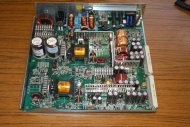 |
 |
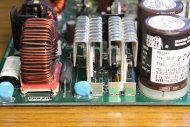 |
 |
1. Taking it apart. There are three modules - the logic capture board at the bottom (front in this pic), the power supply (in center chassis cavity seen here), and the processor assembly (out of sight at rear here.)
The interconnects between modules are three press-fit boards. They just pull off, no screws to undo.
2. The power supply slides out on its own tray, complete with rear panel mains connector, fuses and switch. Apparently Tektronix contracted out the entire power supply design. The board silkscreen says: "Designed by: Martek Power Inc."
A sticker says: Model: PS2251 Rev F, P/N: 119-5806-02, Rev 2. SN: 1195 - 2000. IN: AC 100-240VAC 50/60/440Hz 6A typical. OUT: 3.35VD/35A 5VD/22A 12VD/6A Vfan/2.5A 5VSB/1A 380W maximum.
Naturally there's no mention of this product on Martek's web site. I know my chances of ever getting a schematic for this quite complicated board are zero. Splendid.
3. Oh well, to begin. The mains input chain is the usual filtering series then bridge rectifier. After that there's the big inductor and stuff to be expected with a Power Factor Correction (PFC) primary buck converter. The switching devices are on those big heatsinks at right.
4. A quick multimeter check finds that one of the two devices is a dead short. Literally, like a piece of wire.
Next problem: getting it (or both of them) out. Those heatsinks are thick copper, plated, that will be a pain to desolder due to its rapid heat conductance. But the way the fastening screws are arranged, they can't be removed while the heatsinks are in the board. Also there is active surface-mount circuitry around the base of these transistors, which may also be lightning-damaged, so these heatsinks definitely have to come off. With the transistors attached. I'm loving this more and more.
5. More good news. The thick copper heatsink tabs were pushed through their tight-fit PCB slot-holes, then their ends twisted to lock them in the holes, before soldering.
First step was to remove as much solder as possible, so they could be untwisted with pliers. Even with a fat tip my old Weller soldering iron can barely melt the solder on the tags of these thick copper things. Thank God it's not high melting temp ROHS solder. The photo is after straightening the tab-ends as best I could. In contrast the transistor pins are easy.
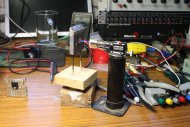 |
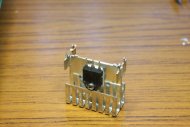 |
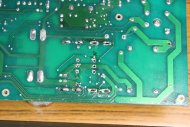 |
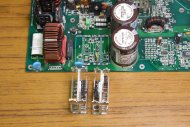 |
1. Trying to desolder the heatsinks with the iron was hopeless. So I resorted to my custom-made big lump of copper. Here it is being heated up with a small blow torch. I judge the temperature by observing how quickly the solder tinning oxidizes.
2. Even with that, extracting the heatsinks pulls out some through plating and pads, since there is too little hole clearance, and the distorted pins are tight in the holes and take out the copper plating as they go. This whole heatsink arrangement is a really bad design imo.
3, 4. One down, then the second.
Both large transistors are FDA24N50, N-Channel MOSFET 500V, 24A, 0.19 Ohms Rds(on). One is indeed a dead short, the other works. The diode also on the 2nd heatsink is OK too. I order 10 pieces of FDA24N50 for US$14.29 via AliExpress that evening of the 7th, and put the disassembled TLA 614 system and parts aside. It's going to be a while.
Nearly two weeks later they were still not marked as shipped. Turns out it's New Year holiday in China and everyone had been away; got back just before I made enquiry. They ship the next day, Feb 19th, and arrived March 2nd.
20160327 Much Later
Due to other time demands, I didn't get to look at the TLA 614 again until March 27th. But I couldn't just solder in the new FET and try it. Since in failing, that FET could have taken out other parts around it. Powering up the board could do even more damage, not to mention that getting those heatsinks out is such a pain that I don't want to have to do it again.
The only option is to trace out enough of the PCB circuit to be able to verify there's nothing else wrong with the PFC switchmode circuitry. Safe enough to assume nothing but that subsystem could be damaged.
To reverse engineer schematics from boards with fairly dense surface mount circuitry, really the only way is to start with photos of the board front and back, align them in photoshop, and use more photoshop layers to draw a clear interconnection diagram while verifying every detail with a multimeter. Then from that generate schematics — in a schematic editor, or on paper for greater drawing convenience but less utility. (I'll do the latter, it's quicker.)
Because setting up my nice new Touptek digital C-mount camera with microscopes and lenses for board inspection is one of the tasks that's been pushed down the queue of jobs, I still had to do this with the Canon EOS 40D. The 18-55mm zoom lens I have for that isn't ideal for doing macro photos of PCBs. It can't zoom in close enough for showing details like part numbers on SMD components.
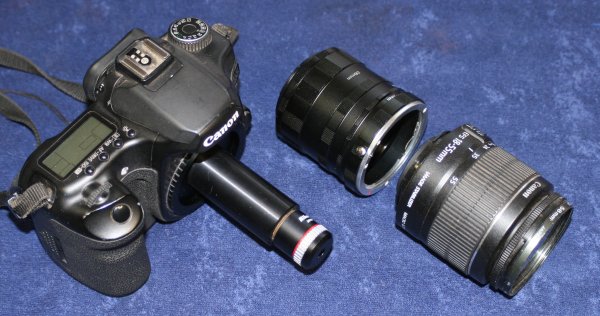 However I have some new adapters to try.
However I have some new adapters to try.
Attached to the camera is a Canon EF to C-mount adapter, with a C-mount 4x magnifier lens and tube. Much like a microscope objective lens.
Beside the camera is a set of EF-format macro extension rings, and the original EF-mount camera lens. There's no electrics in the extension rings, so the lens autofocus etc are inactive. The lens can still be adjusted manually.
The extension has several different length sections; allowing selection of magnification factor.
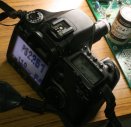 |
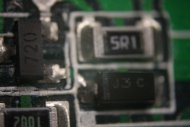 |
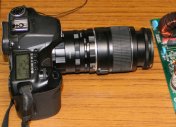 |
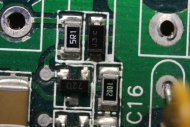 |
1, 2: The c-mount 4x magnifier. It works well, but is much like a microscope in that it has a narrow depth of field, needs very strong lighting of the subject (which is difficult to arrange while holding the camera above the subject.) Focussing by eye using the camera live-view, manually moving the camera for desired focus and view, is difficult to do precisely enough. For some subjects this could work, if the camera was on an adjustable mount. Future project. As it is it's not suitable for what I need now.
3, 4: The standard lens with all the extension tubes mounted. Much better depth of field, and the lens front could be above the high PCB components. This works very well, but would be better still with an adjustable camera mount with X,Y,Z verniers. Definitely something to pursue. For my present purpose, the board area visible at once is too small, while the area with the lens alone is too wide.
Experimenting with fewer extension tubes, I found an optimum with just one shortest tube. And so the final board front and back images, for the photoshop overlays:
 |
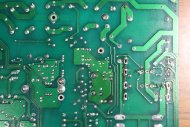 |
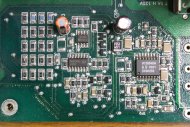 |
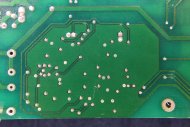 |
1, 2: The power FET and heatsink area. For the PCB rear image I used an earlier wide area image taken with the plain camera lens.
3, 4: Same for the board area that is the Power Factor Correction switchmode supply control circuitry.
 I'd noticed that over much of the board there was a consistent pattern of small scratches at numerous pads. It appears during post-manufacture tests someone dropped the board hard onto a bed of nails test fixture, while not propperly aligned.
I'd noticed that over much of the board there was a consistent pattern of small scratches at numerous pads. It appears during post-manufacture tests someone dropped the board hard onto a bed of nails test fixture, while not propperly aligned.
Here's the result of the track tracing. (In much lower resolution than the working files, plus with JPG blur):


Remember the purpose is to fix the board, not document it fully like Tektronix should have. I didn't have to determine all the schematic, just enough to be able to test if there was any damage beyond the blown 24N50 FET.
I started with the mains input and switching transistor area:
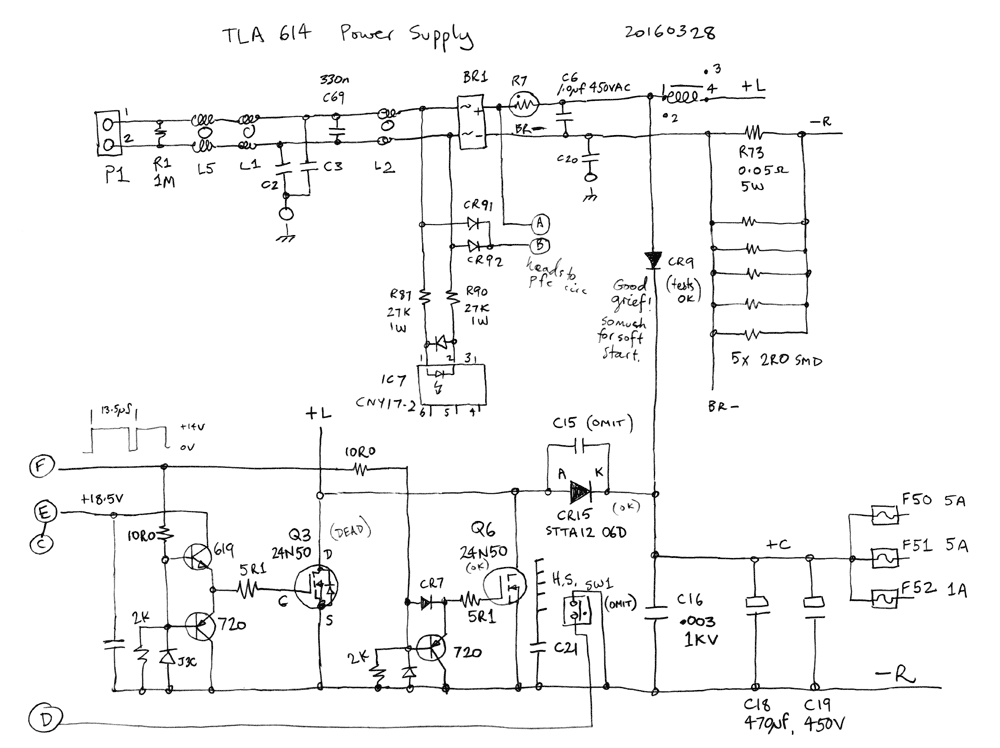
 Relevant data sheets I'd found:
Relevant data sheets I'd found:
3842B_ctlr.pdf
DS1225AD-85.pdf
fda24N50.pdf
smd_619.pdf
smd_720.pdf
ST_2901.pdf
ST_431.pdf
STTA12-06D.pdf
uc3854.pdf
With the above, and the overlay of the PFC circuit, it was obvious what traces E and F to the drive FETs should be doing. E will be a DC supply rail, and F will be the proportional drive signal. Also that the board should power up even without the PFC drive FETs in circuit, due to that ridiculous cheat diode CR9. It charges the main DC supply caps at power-on, the old fashioned peak-clipping way. Then the rest of the circuitry starts up, gets the PFC circuit running, which then boosts the main caps to a higher voltage so CR9 no longer conducts.
So despite the main FETs being missing, the PFC circuit should run, and attempt to drive the FETs. Which provides me with a good test of whether the circuits around the FETs are working.
With the supply powered via an isolation transformer and variac, using "-R" as a scope reference, I wound up the mains voltage. No bangs, and at less than 100VAC the "E" rail popped up to +18.5V and stayed there with further mains input increase. So that's what it is supposed to be. Good. Also the "F" line is a sensible gate drive signal, and even better, the SMD transistors driving the (unconnected) Gate pins of the 24N50s were all OK.
I'm curious why the gate drive circuits of Q3 and Q6 are slightly different. Is it because the UC3854 output drive can't cope with both the gate loads, or is the difference intended to slightly stagger the FET turn-on timing, enough to spread the current spike a little?
More importantly, it looks like it's OK to reassemble. I quickly checked one FET from the bought ones, and it is actually a working power FET. Attached it to the heatsink, soldered everything in, patched the broken heatsink track, then assembled the board to the metal tray. I don't know the output pin arrangements, and don't care. All the rails are very likely working, and even if not I'm not going to spend a week tracing out the rest of the board circuit. Did I mention this board weighs 3Kg, so is a pain to work on? Flipping it back and forth frequently while following traces is muscle building.
Instead I tested it the easy way - plugged it into the TLA 614. Which then powers up, boots and runs fine. Fixed.
But not finished. Now would be a good time to back up that Dallas NV-RAM.
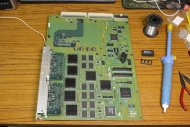 |
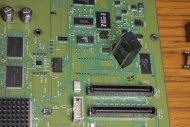 |
 |
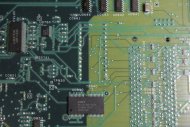 |
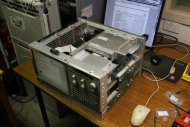 |
That went well too. The DS1225AD-85 unsoldered easily enough, with only the ground pin (14) having serious thermal connection to an inner copper plane. I just couldn't get that one to suck out properly, so extracted the chip with the iron heating that pin. Then couldn't even suck all the solder out of the empty hole, so resorted to drilling out the remnant solder plug. (Carefully, to avoid damaging the copper plate-through. Used a very fine drill in a small pin vice, turned manually.)
1, 2: The capture logic board. Cable inputs are on the bracket at left. DS1225AD already removed.
3, 4: A good quality socket soldered in. There's also the question of what's in the Intel flash chip at U754. I think I need to check that out too. If I was implementing a keyed feature enabling system, I'd keep mating keys in at least two different physical devices. A task for the future.
Read the removed DS1225AD in my TopMax device programmer.
Contents: 20160331_U740_DS1225AD.bin Size is 8KB. Checksum: AEBDh.
Removed chip from programmer, replaced, read again - gets same checksum.
Programmed a newer DS1225AD-85 with same data, put it into the TLA 614 in a socket — the machine boots and runs as before.
Done. Apart from spending 15 minutes searching on the floor for the small front panel power button, which had fallen out of the moulding since I didn't realize it isn't attached. Naturally it had found a good hiding spot. Reassembled the case, no screws left over, put it back on the shelf.
The next item on the ToDo list for my TLAs, is to cut open the old DS1225AD, sufficiently to disconnect and remove the battery, then add a connector to an external replaceable battery. Then do the same (archive the contents and make the battery replaceable) for all the other modules I have for the TLA 721.
This would be a happy ending to the lightning-damaged equipment story, except that in the meantime I'd discovered a couple of other items dead in my Sherlock rack to the right of my desk. Presumably from the same cause. I'll record their repairs here in future.
The supply to my workshop is 3-phase 63A, with the GPO circuits spread across the phases. So to be effective any kind of overvoltage spike suppression scheme would have to be quite beefy. I don't know how to do that.
Lesson learned: I think for approaching lightning storms, I need a power quick disconnect system. Big red button kind of thing.
Luck
Due to some unusual circumstances there's no point going into, I live an oddball kind of life. I'm 60, retired (partly by choice, partly not, and for very complex reasons), have virtually zero income (more complex reasons), and get no government benefits at all (same tangle of reasons.) Effectively I'm usually penniless apart from a few small windfalls now and then. Yet I'm relatively asset rich — a high value property, lots of tools and equipment, big workshop, etc.Socially, apart from a few friends I could be living in a cave on a remote mountain and it would make little difference. This suits me fine; a long trail of discouraging events inspires me to withdraw from society as much as possible. It could be summed up in the phrase 'corporate bastards and general evils loose in the world.' Had enough of it, refuse to participate any more. A kind of one man general strike. I have plenty to keep me busy; the things I relate in this not-a-blog are mostly only minor trivia unrelated to pursuit of my primary interests, which I don't publicise.
But Fate often has plans that don't match one's own. In Oct 2015 Life threw me one of those curve balls. The result is a Side Quest, that I cannot decline. (And also can't detail here.) The problem is, this Quest requires at minimum about 4 to 5 thousand dollars, and potentially much, much more. Depending on circumstances not yet clear.
This is awkward. I hadn't anticipated any such need. I've been relatively wealthy in previous years (hence the high value property and gear) then chose to withdraw — quit full time work and be poor. Thinking this suited me well enough and would be only a minor impediment to my retirement pursuits, while the free time would be more beneficial. I'm old, and only hoped to spend my remaining years quietly pottering on a few private projects. I didn't expect to suddenly be required by all that's Good to carry out any kind of Noble Quest.
So I've been feeling quite low for some months due to my finance-constrained inability to respond. With my non-income (I live on about $50 a week, and don't care if you don't believe that) it's often difficult just to feed my cats. Certainly not possible to save up several thousand dollars. Yes, I'm a crazy old cat guy. I have three. And a few randoms who steal food, with varying degrees of permission.
It's funny how things sometimes work out in unexpected ways.
On 25th February 2016 I was with some friends for an evening of recreational underground touring.

 'Fully enclosed underground watercourse' streambeds vary between plain flat concrete, to rough stones and pebbles much like a riverbed. Wading through one of the latter kind that evening, I spotted something unusual mostly buried in the silt and gravel. Picked it up.
'Fully enclosed underground watercourse' streambeds vary between plain flat concrete, to rough stones and pebbles much like a riverbed. Wading through one of the latter kind that evening, I spotted something unusual mostly buried in the silt and gravel. Picked it up.
This. It's an old, cheap-looking, cracked cast bronze vase. In other words, a strong candidate for jokes about finding Aladdin's lamp.
So obvious that even as I swished the silt out of it, I laughed to my friends that I'd found a magic lamp. General jests from them of "Give it a rub!" "Make a wish!"
I laughed back. But of course, did rub it while making a silent wish.
I then put the lamp/vase in my backpack, and we went on with the enjoyable evening event. For a while I thought sadly of that impossible Quest, and of an awesome angel I greatly admire, who by all I know seems likely imprisioned at the uncaring whim of very evil people. Or at worst, already dead.
On Thursday 10th of March I did a day bushwalk, that involved carrying a 30Kg backpack a long way and spending half the day doing some strenuous rock breaking and carrying. The sledge hammer, steel wedges etc were what made the pack heavy. This and follow up trips will be another story some day (when the work is complete.) I'm 'saving a beach', ha ha. But no, it really is literally that. Got home around nine in the evening, exhausted but feeling good about having made a successful start on the project. Proof of concept is always reassuring.
Friday 11th was a writeoff; muscles so sore I didn't want to do much.
Saturday 12th was better, getting to that 'pleasant soreness' stage. Still not wanting to do anything strenuous. Little did I know.
In the evening I had a phone call from a friend I hadn't heard from in a while. He tells me he's clearing out his house due to selling it and soon moving overseas semi-permanently. "There are some things amongst the stuff that you may like" he says.
His house is in Pymble. On Sunday 13th I drove up there. His situation is a little more dire than he'd mentioned. Main point being, the contractual handover of the empty house is supposed to be on Tuesday, and it is still very full of stuff. He has some physical disability, and the task of clearing the house out had overwhelmed him somewhat. I could see the deadline was wildly impossible at the rate he was going. But with help, perhaps possible. Or only a day or two over the deadline, which was hopefully acceptable.
At the start there was so much to do I was mostly far too busy to take photos. None inside the house. Here's just three, plus my car when I got home Monday morning:
 |
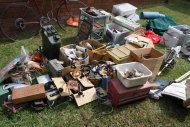 |
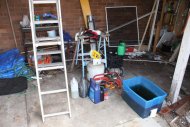 |
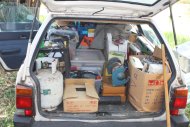 |
Fortunately a stalwart friend of ours (Drac) turned up. Between the three of us, and a hired rubbish removals company at one point, it got done. With only a two day extension needed, which the buyer agreed to. That Sunday we'd worked all through the night. I'd driven home around 7am Monday morning (with a carload of stuff - he was giving almost everything away), unloaded the car, had a few hours sleep, then got back to Pymble at 2pm. More work. Back home around 6pm.
By that stage the house was very close to cleared:
 |
 |
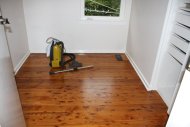 |
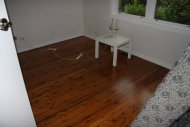 |
 |
A slight panic when I discovered I'd lost a thumb drive with critical and confidential data on it. I'd been silly to keep it in my pocket, while often pulling out my hankerchief to wipe off sweat. The thumb drive must have been entangled and dropped. Into grass I wouldn't hear it fall. Thinking I'd dropped it at his place I didn't like the idea of the new owner finding it and reading the files. Was prepared to go back and search for it on the lawn with a metal detector, but thought I'd check my own overgrown lawn first, where I'd walked briefly on Monday morning. Fortunately found it there, completely invisible to the eye. I like my metal detector!
By now the two main rooms of my workshop plus the kitchen and free space in the shed were piled up with storage crates and boxes of mixed 'stuff', that I'd had very little chance to look at carefully while clearing his place. Especially since I usually wasn't wearing my glasses at the time.
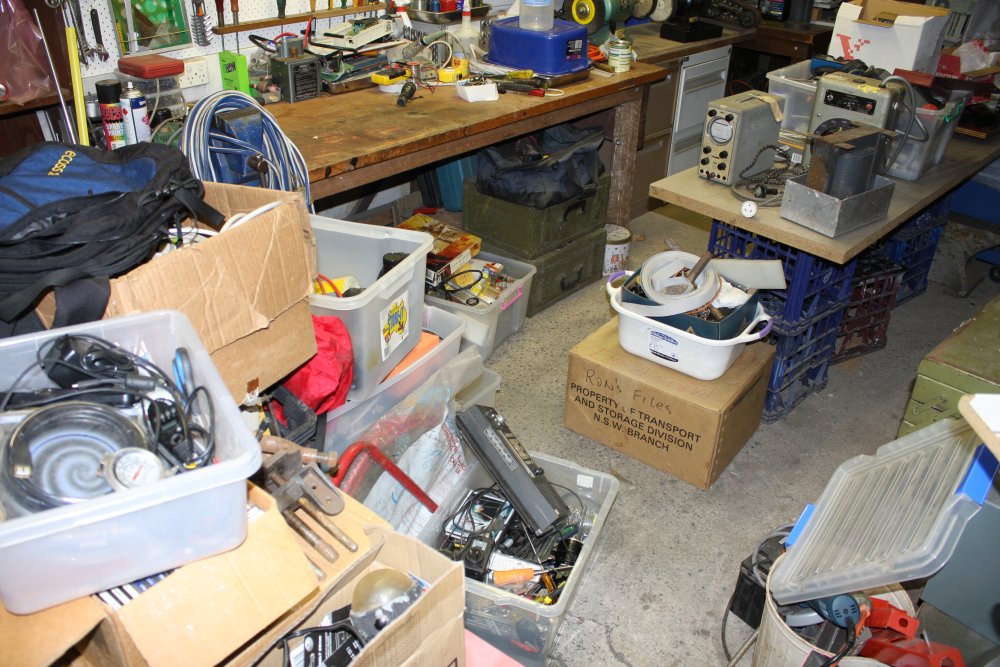
With so much space chocked, my own projects were stalled till I cleared it. So that was a priority.
The house had contained a lot of old tools and stuff that had been his dad's. His father was a materials scientist who worked for the CSIRO from 1986 to the late 1990s. The tools hadn't been stored well, and by now were mostly rusty. I started on these first.
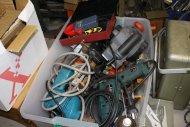 |
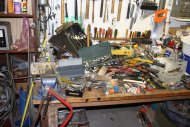 |
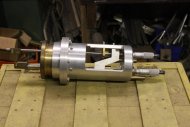 |
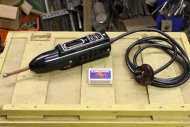 |
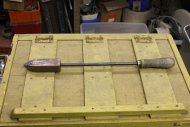 |
1: Box of power tools. 2: Hand tools, everything in that pile on the bench. 3: A high vacuum linear motion feedthrough port. 4: A vacuum systems HV leak detector. Basically a hand-held Tesla coil. 5: Old school soldering iron.
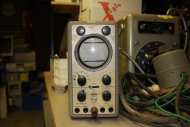 |
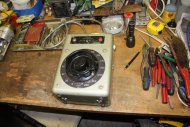 |
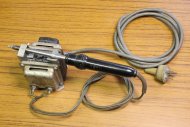 |
 |
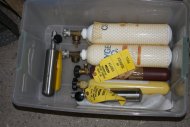 |
1: A very antique oscilloscope. 2: Big Variac, and 3: Old Scope soldering iron, both marked AAEC (Australian Atomic Energy Commission.) 4: A collection of elements and interesting substances. 5. Some lab gas bottles, containing.... (reads labels for the first time) oh my God!
While sorting stuff at his place into piles to take home, send to Vinnies, or send to the dump, I'd found this crate with the lab gas bottles. I'd assumed they were empty, and didn't put on my glasses to read the labels then. Asking my friend about them, he'd said "They're yours." I put the crate in my pile to take home since I'm looking for small gas sample bottles for my vacuum system project.
Now I discover I own:
- One cylinder of Helium-3. 99.95+% Contains < 0.05% 4He. 2L Cambridge Isotope Laboratories. Lot I-2306 Stainless cylinder, 5-92. Has intact 'full' tag. Original end cap on outlet.
- One cylinder of Nitrogen-15. 99/ 2L Cambridge Isotope Laboratories. Lot EB-314 Stainless cylinder, 5-92. Has intact 'full' tag. Original end cap on outlet.
- One cylinder of Oxygen-18. 97.87% 2.034L Enritech Ltd (Israel) Can't see any date code or serial #. Yellow cylinder. Has intact 'full' tag. Original plug on outlet.
- Two cylinders of Oxygen-18. Mfr: CEA=ORIS Bureau des isotopes stables. White larger cylinders with mesh impact guards.
- Cyl 4a. Original plug on outlet. 97.33%, 1 litre, Bouteille: 3643. No usage indicator tag.
- Cyl 4b. Has outlet port not original plug (ie probably was in use) 98%, 1 litre, Bouteille: 5653. No usage indicator tag.
What are they worth? I don't know yet, but I do know that Helium-3 is extremely rare and valuable. Web sources mention US$2000 per liter, and that was in 2010. But as for the practicalities of actually selling a couple of liters, it remains to be seen.
Relative abundancies on Earth of these isotopes, compared to the common ones.
(Ref: http://www.webelements.com/ )
| 3He | 0.000137% |
| 4He | 99.999863% |
| 14N | 99.632% |
| 15N | 0.368% |
| 16O | 99.757% |
| 17O | 0.038% |
| 18O | 0.205% |
The Nitrogen-15 and Oxygen-18 can't be cheap either, if only due to the cost of refining them to such purity. There are potentially several thousand dollars in this old plastic crate. Hmmm... I wonder if it can be realized, sufficiently to fund my quest? Oh and hey, it's been a little over two weeks since I rubbed that old brass vase. Ha ha, that's pretty fast wish service!
But first... did my friend understand what he gave me? I had to make sure he's still OK with it, knowing what they are. I called him, and he laughed. "I was waiting for you to realise." He knew. Even wrote me out a statement of transfer of ownership, which was nice of him. Apparently his dad had saved them from being thrown out when a CSIRO project terminated back in the mid 1990s. Back when He-3 was much cheaper. My friend said his dad wouldn't have bothered if the cylinders weren't of scientific value, so they very likely are what they seem — unopened and full cylinders of high purity rare stable isotopes.
There's a discussion thread about this at Unexpected treasure find. And fixing a broken multimeter from among the stuff.
Also my For Sale listing for the cylinders.
Which is all very nice, but it could take a long time to find a buyer for those rare gases. Meanwhile there's a high degree of urgency to that Quest. That old brass vase is now on my bookshelf, and to carry the conceit further I mentioned the timeliness concern.
I also have a small number of ex-military radios of historical value for sale, but hadn't done anything about those for a long while. They are valuable, but only to a very specific type of collector. Who are hard to find. On 28th March someone contacted me out of the blue, wanting to buy one, or perhaps two of the GRC-106 radio sets. Seems like at least one is a definite, so that's some more unexpected funds. With a date on them this time, it's quite soon.
The run of luck continued! On 31st March, I was given 8 large solar panels. No money involved here, but they are a direct consequence of that lightning storm. See the post at eevblog. A nice boost for my ambition to achieve power independence (or at least reduced power bills and/or power outage backup) for my workshop. I already have a bank of large batteries, now just need to find (or build) a suitable power electronics pack. Solar cells and battery management, plus three phase mains output.
The panels also had an interesting pattern of damage from the lightning strike. Which surprisingly didn't seem to impair the function of the cells.
Lament
If you like cats, and are easily upset, perhaps you'd better skip this one. It's quite sad. Well up there in the 'Life is Cruel' rankings.Some background: My cats are fed outside, under cover. As a result, other neighborhood cats can come and help themselves to leftover food.
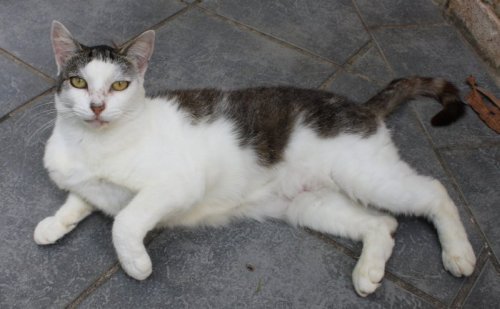
Then there's Storm (at right), a huge, wiry and relatively intelligent male, who is either stray or owned by some neighbor, I'm not sure. He'd be welcome to stay, if he wanted to.
|
Sometimes I end up befriending ones I like, and perhaps adopt them if they don't have a home. One of my current cats (Sally, at left) was like that — clearly an abandoned stray, who'd been wild for quite a while. She remains a yard cat, entirely because she's too retarded to learn to use the cat flap. Next winter I'll make another attempt to educate her. But don't expect success.
|
 Then there's Tiny (above) and Blanc (right), sisters I've raised from kittens. They are both very cute and affectionate cats, though Blanc has to be the dumbest creature I've ever owned. Very talkative, but a terribly limited range of conversation.
Then there's Tiny (above) and Blanc (right), sisters I've raised from kittens. They are both very cute and affectionate cats, though Blanc has to be the dumbest creature I've ever owned. Very talkative, but a terribly limited range of conversation.
So those are my current cats.
About a couple of months ago, I'd seen a small tortise shell cat in the yard and out the front a few times, as it was coming or going from my cats' food bowls. Always at night, and I hadn't been able to get close to it. But I could see there was something very wrong. In the hindquarters area, there was a pink and glistening object hanging down. About the size of a large cherry, it looked really terrible. But the cat was shy and would run away if I tried to approach, so I couldn't get close enough to see it clearly. Could not tell if it was male or female, but later found out she's female.
For a long while I didn't see this cat again. I'd assumed she had died from whatever it was.
On Thursday 20160331 evening I was outside and noticed this same cat hiding in the long grass near the cat food bowls. She didn't run away when I got closer, and I could see she was in very poor condition. Very thin, obviously starving. As she was sitting I couldn't see her rear and that object. When I tried carefully reaching a hand towards her, open palm up, hoping to let her sniff my fingertips, she looked ready to take flight when I got about a foot away. I could tell she was desperate to get to the food, but very conflicted about my presence.
So I tried something different. I pulled a long grass straw, and held that out to her. Being small and thin, it didn't scare her, even close. I tried stroking the straw end down her back.
Amazing! The impression I got was that the soft touch brought back old memories for her. Pleasant ones, from before she was abandoned and her other troubles began. She looked at me differently, not in fear any more. Then got up and walked the meter to me and leaned against my thigh (I was kneeling in the grass.) Without any hesitation she let me stroke her head, then scratch her under the chin.
I spent a while petting and stroking her, realizing how very thin she was. Also, now up close I could see the awful thing at her rear end. It wasn't one of the worst possibilities I'd guessed, but was pretty bad. Now it was much larger than it had been last time I'd seen her. It was a growth, huge, hanging like a ripe fleshy wet fruit by a string of flesh from the rear of her right back leg. It stank too, like rotting flesh. I think parts of it, growing past the limits of the blood supply, actually were dead and rotting. As soon as I saw it I knew I had to get her to the vet, as soon as possible.
Right now though, she needed food. Getting up calmly so as not to frighten her, I walked to where the cat bowls were (inside a shed) and brought the one with fresh tinned catfood to outside, where she could see me. Put it down on the ground and beckoned to her, pointing to the food.
She understood and came over to me, started eating as fast as she could. At this point, while thinking about how I could make sure of getting her to the vet tomorrow morning, I went and got a camera. If she ran away before I could secure her somehow, at least I wanted to show the vet pictures.
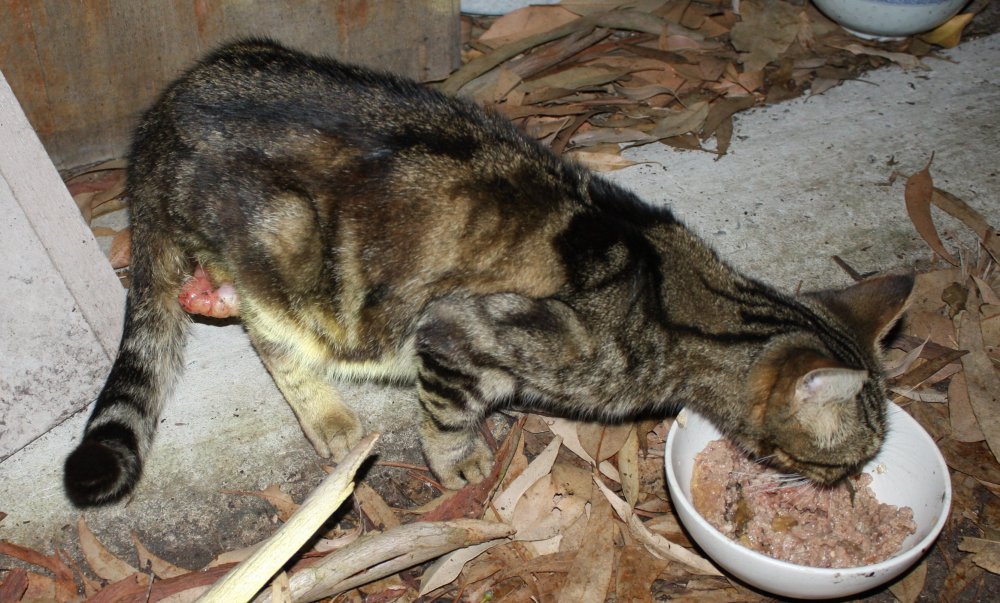
I had to rummage around in the storage shed, looking for a cat cage. Found two, but the larger one had had it due to the plastic becoming old and cracking. That left the small one, with the top wire hatch. Way too small to leave her in overnight. But I could use it to get her inside the building, where I could keep her comfortably in one room. For a while I let her keep eating, while petting her gently as she ate. She didn't seem to mind the attention, or at least wasn't growling.
Then I tried picking her up. I'd expected this to be a big drama, but it wasn't. She quite calmly let me pick her up, and even lower her into the cage. But the moment I let her go, to reach to flip the hatch over on top, she hopped out. I could have blocked her, but I didn't want to lose her confidence, so just let her go. Which I guess was good, since she stopped a few feet away. I moved over to her quietly, and checked - yes, she would still let me pat her.
Hmm....
I was pretty sure she wasn't going to stand for being lowered into the cage again. So what to do? I tried picking her up a little, then putting her down. She tolerated it. All right...
So I set up my workshop as a kind of cat trap, which just meant opening the outside door and closing the connecting door to the electronics lab. Then put on a pair of leather gloves. This was only going to get one try, and if she decided she wasn't having any of it, it would have to be a battle. If I could carry her inside then push the door closed, she'd be going to the vet's tomorrow. If she got away, I'd probably never see her again, and with a tumor like that which was obviously severely restricting her scavenging ability and making her sick, she'd die soon. It's too bad one can't explain these things to cats.
She was still in the grass where I'd left her. I let her sniff the gloves, then patted her with them to get her used to these new strange things. Then picked her up. She wasn't entirely happy but didn't struggle. Talking softly to her, I walked over to the doorway. Still no struggle! I stepped inside, and closed the door. Put her down, and kneeled down beside her, took off the gloves and petted her some more. She was still being trusting and enjoying the pats. I got the impression she really liked this, and hadn't had any pats for a very long time. The strange room didn't seem to bother her.
Excellent. Now I could go through to the electronics lab, then outside, with a series of doors that could act as 'cat-locks', to be sure she couldn't slip back outside. Also to stop my cats going in and confronting her. I went and got more food and water in bowls for her. Then organised a litter tray - made of a huge old hard disk cover, with dry leaf mulch filling. Next made her a bed, of a cardboard box and some cloth. Finally put a small 15W bulb in one of the workshop lights, so the room wouldn't be in complete darkness overnight.
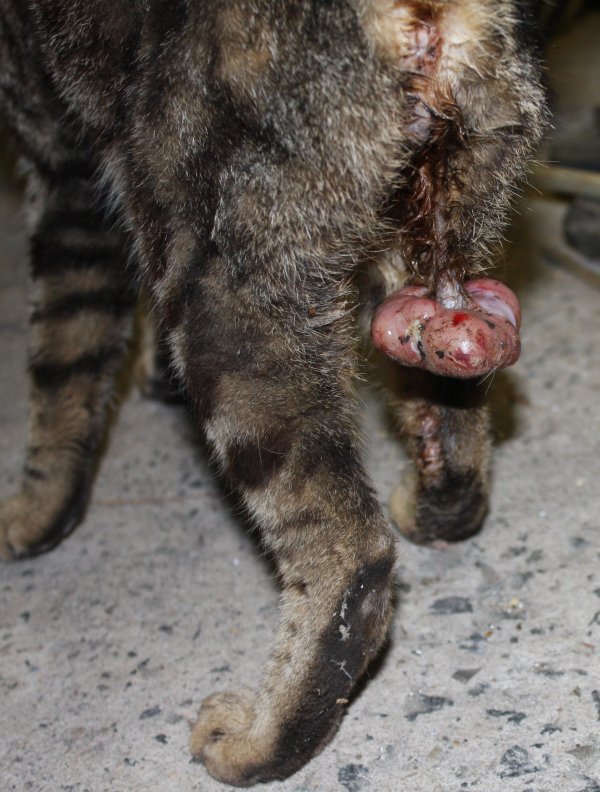 I spent a lot of time with her, making sure she knew she wasn't forgotten and trapped in some strange place. She spent most of her time eating. Bottomless pit appetite, so much that I was considering taking the food away to stop her making herself sick. She seemed to be settling in well though. Very appreciative of attention. She even liked the bed I'd made for her.
I spent a lot of time with her, making sure she knew she wasn't forgotten and trapped in some strange place. She spent most of her time eating. Bottomless pit appetite, so much that I was considering taking the food away to stop her making herself sick. She seemed to be settling in well though. Very appreciative of attention. She even liked the bed I'd made for her.
On Friday morning she seemed much happier (being full of food I suppose) so before taking her to the vet I took some better pictures of her tumor. She's a pretty cat, I really hoped something can be done about this. Looks to me like it would be easy to remove it due to the thin connection 'stalk', but what would I know? Hopefully there's no secondaries.
In the pics the matted fur is because the tumor is wet and sticky. Also I think she had a bowel upset, and the dangling tumor interferes with her toilet. It's messy, but not as bad as it looks.
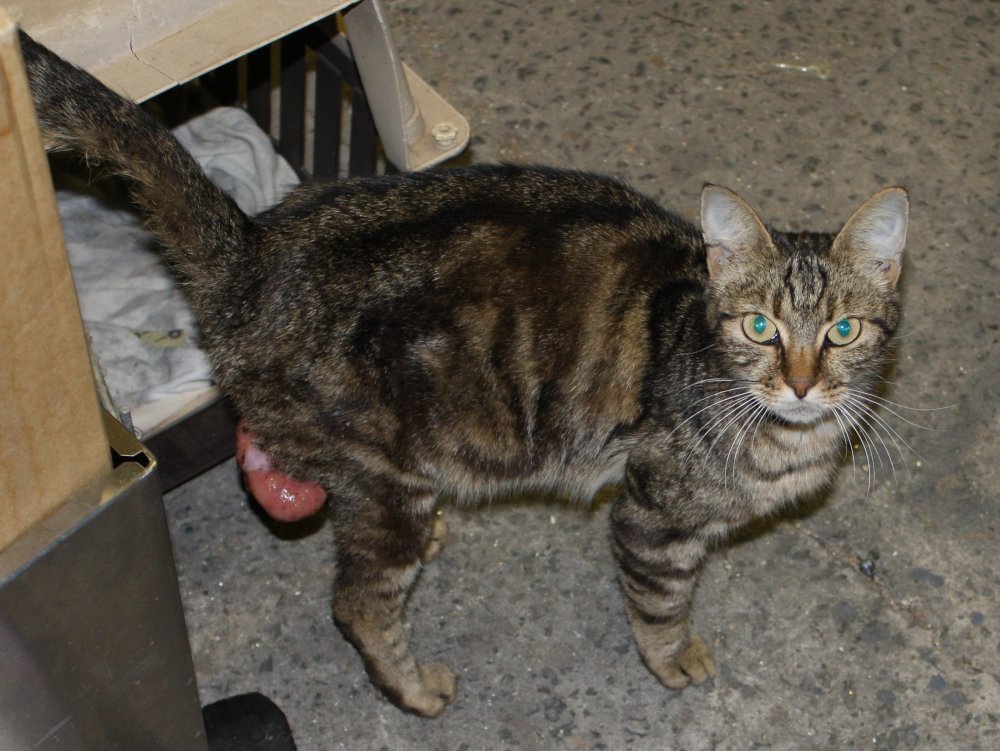
She took the drive to the vets remarkably well. A bit of concern at first, then just settled down in the cage and calmly watched progress.
The vetinary staff were horrified, understandably. They also very kindly gave me a discount from the usual $55 consulting fee, and also offered to do the operation for free, which was greatly appreciated since I only had $50. (That was supposed to last till next Monday. But never mind.) They said I should come back at 4pm to pick her up.
Around midday they phoned me. They'd been examining her, and could feel nodules in her abdomen. Meaning it had metastacised. The vet estimated that with such a malignant form of tumor the cat would probably only live a few more weeks to months. Did I want to have her put down now? Or look after her for as long as she lasted? They'd still remove the leg tumor if I wanted.
Sigh. Well, a promise to a cat... what's it worth? But it's my promise. I'd said to her when putting her in the cage that morning that she would be rid of that thing soon. And besides, perhaps her fate is not as certain as the vet thinks.
My grandmother, my father and my best friend all died of cancer. My best friend in just six months from diagnosis, back in 2004. My father back in 1996, and at that time I had no access to net search engines, such as they were then. Even in 2004 I was still only starting to develop the habit of digging deep for knowledge, casting a wide net to find the unexpected. Only after I'd recovered somewhat from the pain of my best friend dying (and other extreme life dramas around that time) did I think to search on cancer-related topics. A tardiness that is hard to explain in hindsight, since I've always had a strong interest in all topics related to genetics. As a programmer, the entire field fascinates me. A naturally evolved computing system, and all the resulting stunning quirks of the DNA processing machinery... they're wonderful. Except for the really bad program glitches, like cancer. But still fascinating.
Anyway, I'd learned some things. There's a tale of powerful corporate and entrenched political interests versus a truth that is highly inconvenient to them and their profits. This is not the place to go into full details of what and how, other than to say, google vitamin B17, Laetrile, apricot seeds. Naturally occuring substances can't be patented, and can't easily be banned (not for want of trying.) But the establishment can't allow apricot seeds as a cancer cure to become widely known, because that would jeopardize billions of dollars in sales of existing pharmaceutical company cancer treatments.
I'd come across this topic only after my friend died, which makes me very pissed off with myself and those who suppress the Laetrile treatments. But fortunately I learned these things before I had my own cancer scare, around 2011, which meant I could try them out myself.
 Consequently I usually have a stock of apricot seeds, and take them prophylactically. My own cancer seems to be gone. Ha ha... I recall being told as a child "You must never eat apricot seeds, they contain cyanide and you'll die!"
Consequently I usually have a stock of apricot seeds, and take them prophylactically. My own cancer seems to be gone. Ha ha... I recall being told as a child "You must never eat apricot seeds, they contain cyanide and you'll die!"
Well yes, they do. But so does vitamin B12, in a similar form, and without vitamin B12 you definitely will die. For years now I usually eat 8 apricot seeds a day and have not the slightest ill effect. So I can personally report that "apricot seeds will kill you" warning was complete bullshit.
Very likely deliberate lying bullshit too, since in many cultures they are commonly eaten, and that is widely known. What is also known, is that in cultures where apricot seeds are part of the routine daily diet, cancer is virtually non-existent. It's interesting that the anti-Laetrille/apricot-seeds campaign seems to have been in place so long, since at least the 1960s. Let that sink in good, and think about what it means in terms of knowledge among a few, and their intent. That's a lot of deaths by cancer on certain people's hands.
Anyway... I assured the vet that I'd rather not have the cat put down today, and that I'd give her a pleasant life for however long she has left. I picked her up from the vet's at 4pm.
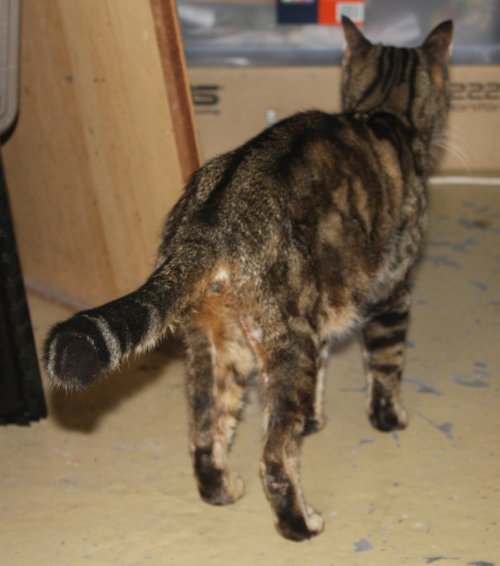 Here she is shortly after her return. No dangling cluster of corruption, just a neat sutured incision on the back of her right leg. She's still very thin and scraggly looking of course.
Here she is shortly after her return. No dangling cluster of corruption, just a neat sutured incision on the back of her right leg. She's still very thin and scraggly looking of course.
With plenty of food, milk & egg, and rest, she quickly picked up. She'd been 3 Kg on her first visit, a week later she's 3.7 Kg.



At her one week vet checkup today on the 7th, the vet was surprised to find the internal nodules much smaller, already barely noticable. I'm to take her (still haven't thought of a good name) back again in another week. The vet is as interested to see her progress as I am.
Of course if I actually suggested giving a cat a careful daily portion of apricot seeds ground up in her food, I'd probably get a visit from animal welfare. Never mind that in the vet's opinion this cat only had a few weeks to live due to having a metastacised very nasty cancer.
In my opinion, the whole world has a nasty form of cancer. Which needs radical and urgent corrective measures, but is very unlikely to get it.
She's had a really bad serve of life's unkindest tricks. Maybe things are looking up for her, but it's unwise to get too hopeful at this stage. I'll be very sad if this lovely little cat, who is barely grown out of her kitten-hood, does end up dying fairly soon from a horrible cancer. But we'll see. She won't if I can prevent it.
I'll update in future with any news.

